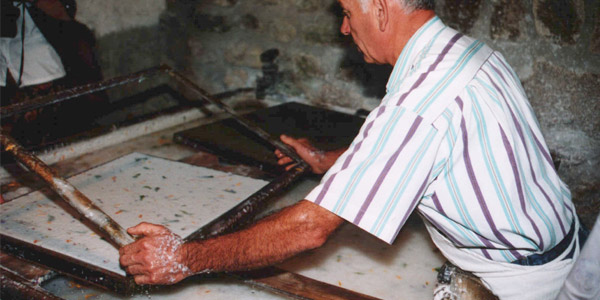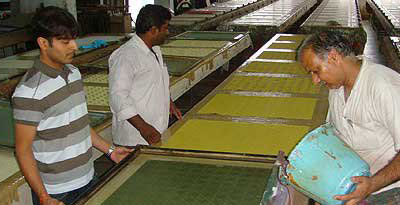
Handmade paper is a layer of entwined fibres held together by the natural internal bonding properties of cellulose fibres by hand, sheet by sheet on moulds in suspension of fibres in water with or without sizing.
The history of paper dates back to the history of human culture and civilization. The Egyptians, Greeks and Romans wrote on “Papyrus”, a paper – like material. Today’s kind of paper was first developed and used in China. Since its birth the paper was the most important carrier of information in the past. Growth of population and need to transfer the knowledge, education and information to the society at large were the forcing factors for stupendous increase in the production of paper. In former times paper was a valuable product and paper making an art – that was often kept secret because of the outstanding advantages of the product. The handmade paper making in India goes as far back as to the 3rd century BC. Handmade paper making is a traditional art that has been practised by a particular class of people for generations together. This art has been passed on from one generation of craftsmen to another. These craftsmen are known as "Kagzi's". Their name is derived from the Urdu word 'kavas', which means paper. The size of this community has dwindled over the years. There is a small settlement of 'Kagzi's' in Sanganer near Jaipur, where a section of this community settled thousands of years ago. They claimed that they were originally from Turkey and from there moved to China and then finally settled in India.

In Sanganer the 'Kagzi' community is the primary owner of the handmade paper industry in the town. Their history goes back to the 14th century when the ruler was Feroze Shah Tughlaq. Even in those days the royalty used handmade paper made by them for official documents, miniature paintings, calligraphy, and to make copies of the Holy Quran and to maintain account books. In the 16th century the then ruler of Amber, Raja Man Singh brought the Kagzis to Sanganer and settled them on the bank of the river Saraswati, where clean water was easily available. Thus the town emerged as one of the biggest paper producing centers in north India.
Under the British handmade paper received a serious setback as the British encouraged the import of mill-made paper from the Western countries. By the 1930s there were only a handful of people from this community practicing their traditional trade. At this point, Mahatma Gandhi provided them with the much-needed support by buying handmade paper in bulk for his Ashram and other associates. After independence, the Khadi and Village Industries Commission (KVIC) included handmade paper in the list of crafts to be promoted. Over the years the handmade paper industry has grown slowly but steadily and is today a major player in the world market, exporting a major portion of its production.
Copyrights © 2018 KNHPI. All rights reserved || Powered By: CeSPL